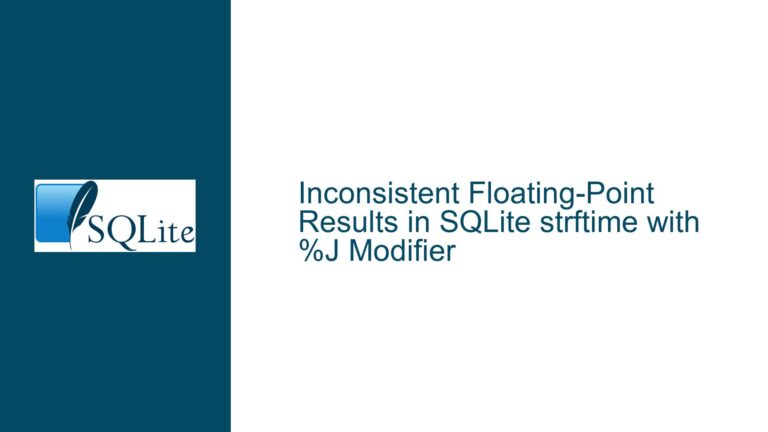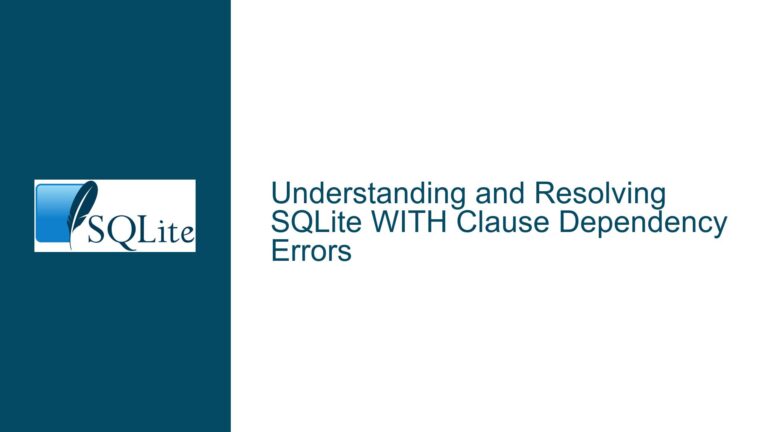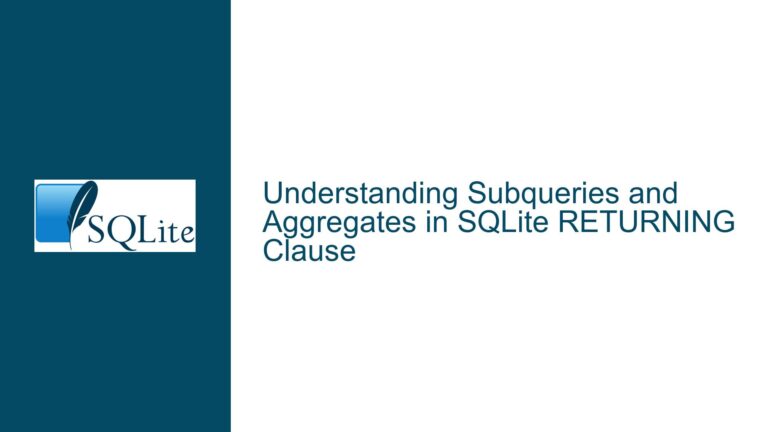Grouping and Querying Event Times in SQLite with Non-Standard Date Formats
Handling Non-Standard Date and Time Formats in SQLite
When working with SQLite, one of the most common challenges is dealing with non-standard date and time formats. In the provided scenario, the trafficdata table stores dates and times in a format that is not natively supported by SQLite’s date and time functions. Specifically, the EventDate column uses a M/D/YYYY format, and the EventTime column uses a h:mm:ss AM/PM format. This makes it difficult to perform time-based queries, such as grouping events by hour or filtering events within a specific time range.
The primary issue arises because SQLite’s date and time functions expect dates and times to be in ISO8601 format (YYYY-MM-DD HH:MM:SS). When dates and times are stored in non-standard formats, SQLite cannot directly interpret them, leading to errors or incorrect results when performing queries. For example, attempting to filter events between 8:00:00 PM and 10:00:00 PM using a BETWEEN clause will fail because SQLite cannot correctly parse the h:mm:ss AM/PM format.
To address this, we need to transform the non-standard date and time formats into a format that SQLite can understand. This involves parsing the EventDate and EventTime columns, converting them into a unified timestamp, and then performing the necessary queries on the transformed data. This process requires a combination of string manipulation functions and SQLite’s date and time functions.
Parsing and Converting Non-Standard Date and Time Formats
The first step in resolving this issue is to parse the EventDate and EventTime columns and convert them into a standardized format. This can be achieved using SQLite’s string manipulation functions such as substr, instr, and printf, along with conditional logic to handle the AM/PM conversion.
Consider the following SQL query, which creates a view named trafficdatafixed that combines the EventDate and EventTime columns into a single timestamp column in ISO8601 format:
CREATE VIEW trafficdatafixed AS
SELECT *,
datetime(
substr(EventDate, length(EventDate)-3, 4) || '-' ||
printf('%02d', substr(EventDate, 1, instr(EventDate, '/') - 1) + 0) || '-' ||
printf('%02d', trim(substr(EventDate, instr(EventDate, '/') + 1, 2), '/') + 0) || ' ' ||
printf('%02d', (substr(EventTime, 1, instr(EventTime, ':') - 1) + iif(instr(EventTime, 'PM') > 1, 12, 0)) % 24) ||
substr(EventTime, instr(EventTime, ':'), 6)
) AS timestamp
FROM trafficdata;
This query performs the following steps:
- Extracting the Year: The
substr(EventDate, length(EventDate)-3, 4)function extracts the last four characters of theEventDatestring, which represent the year. - Extracting the Month: The
substr(EventDate, 1, instr(EventDate, '/') - 1)function extracts the month from theEventDatestring. Theprintf('%02d', ...)function ensures that the month is always two digits. - Extracting the Day: The
trim(substr(EventDate, instr(EventDate, '/') + 1, 2), '/')function extracts the day from theEventDatestring and removes any trailing slashes. - Handling AM/PM: The
substr(EventTime, 1, instr(EventTime, ':') - 1)function extracts the hour from theEventTimestring. Theiif(instr(EventTime, 'PM') > 1, 12, 0)function adds 12 to the hour if the time is in the PM period. - Combining the Components: The
datetime(...)function combines the extracted year, month, day, hour, minute, and second into a single ISO8601 timestamp.
Once the trafficdatafixed view is created, you can perform time-based queries on the timestamp column. For example, to count the number of events that occurred between 8 PM and 10 PM, you can use the following query:
SELECT strftime('%H', timestamp) AS hour, COUNT(*) AS count
FROM trafficdatafixed
WHERE timestamp BETWEEN '2021-04-10 20:00:00' AND '2021-04-10 22:00:00'
GROUP BY hour;
This query uses the strftime function to extract the hour from the timestamp column and then groups the results by hour. The BETWEEN clause filters the events that occurred between 8 PM and 10 PM.
Optimizing Queries with Common Table Expressions (CTEs)
Another approach to solving this problem is to use Common Table Expressions (CTEs). CTEs allow you to break down complex queries into simpler, more manageable parts. In this case, you can create a CTE that extracts the hour from the EventTime column and then use the CTE to perform the necessary grouping and counting.
Consider the following SQL query, which uses a CTE to extract the hour from the EventTime column and then groups the events by hour:
WITH HR(EventDate, EventTime, EventHour) AS (
SELECT EventDate, EventTime,
CAST(substr(EventTime, 0, instr(EventTime, ':')) AS INT) % 12 +
CASE WHEN EventTime LIKE '%PM' THEN 12 ELSE 0 END
FROM trafficdata
)
SELECT EventDate, EventHour, COUNT(*) AS AccidentsInHour
FROM HR
GROUP BY EventDate, EventHour;
This query performs the following steps:
- Extracting the Hour: The
substr(EventTime, 0, instr(EventTime, ':'))function extracts the hour from theEventTimestring. The% 12operation ensures that 12 AM is correctly converted to 0, and 12 PM is correctly converted to 12. - Handling AM/PM: The
CASE WHEN EventTime LIKE '%PM' THEN 12 ELSE 0 ENDfunction adds 12 to the hour if the time is in the PM period. - Grouping by Hour: The
GROUP BY EventDate, EventHourclause groups the events by date and hour, and theCOUNT(*)function counts the number of events in each group.
The result of this query is a table that shows the number of events that occurred in each hour of the day. For example:
| EventDate | EventHour | AccidentsInHour |
|---|---|---|
| 4/10/2021 | 20 | 2 |
| 4/10/2021 | 21 | 3 |
| 4/10/2021 | 22 | 2 |
This approach is particularly useful when you need to perform multiple time-based queries on the same dataset. By creating a CTE that extracts the hour from the EventTime column, you can simplify subsequent queries and avoid repeating the same string manipulation logic.
Best Practices for Handling Date and Time in SQLite
While the above solutions address the immediate issue of querying non-standard date and time formats, it is important to consider best practices for handling date and time in SQLite to avoid similar issues in the future. Here are some recommendations:
- Use ISO8601 Format: Whenever possible, store dates and times in ISO8601 format (
YYYY-MM-DD HH:MM:SS). This format is natively supported by SQLite’s date and time functions, making it easier to perform time-based queries. - Combine Date and Time into a Single Column: Storing dates and times in separate columns can complicate queries, especially when dealing with time zones or daylight saving time. Combining date and time into a single column simplifies queries and ensures that the data is always in a consistent format.
- Use SQLite’s Date and Time Functions: SQLite provides a robust set of date and time functions, including
datetime,strftime, andjulianday. These functions can be used to perform a wide range of time-based calculations, such as extracting specific components of a date or calculating the difference between two dates. - Validate and Normalize Data: Before inserting data into the database, validate and normalize date and time values to ensure that they are in the correct format. This can be done using application-level logic or SQLite’s
CHECKconstraints.
By following these best practices, you can avoid many of the common pitfalls associated with handling date and time in SQLite and ensure that your queries are both efficient and accurate.
Conclusion
Handling non-standard date and time formats in SQLite can be challenging, but it is not insurmountable. By using a combination of string manipulation functions, SQLite’s date and time functions, and Common Table Expressions, you can transform non-standard date and time values into a format that SQLite can understand and query effectively. Additionally, by following best practices for handling date and time in SQLite, you can avoid similar issues in the future and ensure that your database is both robust and easy to work with.
In summary, the key steps to resolving this issue are:
- Parse and Convert Non-Standard Formats: Use SQLite’s string manipulation functions to extract and convert non-standard date and time values into a standardized format.
- Use CTEs for Complex Queries: Break down complex queries into simpler parts using Common Table Expressions.
- Follow Best Practices: Store dates and times in ISO8601 format, combine date and time into a single column, and validate and normalize data before inserting it into the database.
By following these steps, you can effectively handle non-standard date and time formats in SQLite and perform the necessary time-based queries with confidence.






